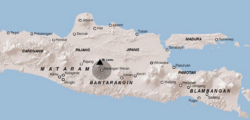Bantarangin Sunanate
Bantarangin Sunanate Kasunanan Bantarangin | |||||||||||||||||||||||
|---|---|---|---|---|---|---|---|---|---|---|---|---|---|---|---|---|---|---|---|---|---|---|---|
| 1517–1757 | |||||||||||||||||||||||
|
Flag | |||||||||||||||||||||||
| Motto: Mukti Digdaya Hangrungkebi | |||||||||||||||||||||||
 The Map of Bantarangin Sunanate during the reign of Panembahan Pakunata III | |||||||||||||||||||||||
| Capital | Sarangan Wetan (1517-1648) Liman (since 1648) | ||||||||||||||||||||||
| Common languages | |||||||||||||||||||||||
| Religion | Islam~78% Hindu~15% Kejawen~7% | ||||||||||||||||||||||
| Government | Pakuan (1517-1647)
Absolute monarchy Islamic Javanism | ||||||||||||||||||||||
| Susuhunan, Panembahan | |||||||||||||||||||||||
• 1517-1520 (First) | Panembahan Ageng | ||||||||||||||||||||||
• 1720-1757 (Last) | Pakunagara V | ||||||||||||||||||||||
| Dinasty | |||||||||||||||||||||||
• 1517-1647 | Sapurbaning Lor-Turanawangsa | ||||||||||||||||||||||
• 1648-1757 | Pakunagaran | ||||||||||||||||||||||
| Pepatih Dalem | |||||||||||||||||||||||
• 1517-1518 (First) | KRHT. Wiranegara I | ||||||||||||||||||||||
• Last | KRH. Yudhayana | ||||||||||||||||||||||
| History | |||||||||||||||||||||||
• Pakuan Establishment | 1516 | ||||||||||||||||||||||
• Establishment | 1517 | ||||||||||||||||||||||
• Sabdaraja Sunan Anom Sriwijayan | 1525 | ||||||||||||||||||||||
• Sarangan-Liman War | 1647-1648 | ||||||||||||||||||||||
• Sabdatama Pakunegaran | 1648 | ||||||||||||||||||||||
• Treaty of Wengker | 1757 | ||||||||||||||||||||||
| |||||||||||||||||||||||
| Today part of | Indonesia | ||||||||||||||||||||||
Bantarangin Sunanate (Hanacaraka: ꦤꦒꦫꦶꦏꦱꦸꦤꦤ꧀ꦤꦤ꧀ꦧꦤ꧀ꦠꦫꦔꦶꦤ꧀), romanization: Nagari Kasunanan Bantarangin, Javanese pronounciation: /mbɑn:tɑrɑŋɪn/, was an independent kingdom located in the historical region Bantarangin, in the southeast slope of Mt. Lawu. The Sunanate was established by Ki Ageng Mertapa Turanawangsa, which later called Sunan Sepuh Sriwijayan (r. 1517-1520). It existed from the early 15th century until its dissolution in mid-18th century amid the Javanese Wars of Succession. The kingdom had played role in series of war such as Bantarangin-Demak-Pajang War, Second Geger Pakemuningan, and Javanese Wars of Succession along with their allies. Bantarangin reached its glorious and victorious peak, both economy and power during the reign of Susuhunan Hamangkuturana Agung (r. 1520-1540) and Pakunagara I (r. 1648-1679), in fact they lost their influence of power after the death of the Panembahan Pakunata IV (r. 1587-1607). They began to feel threatened by several uprisings in some nearby regions.
Etymology
The name "Bantarangin" was taken from a legend, in the era of Singhasari. The story told about the temptation between love and war, Prabu Kelanasenwandana the king of Bantarangin against Prabu Singabarong the king of Lodaya, they attempt and compete to gain Dewi Sanggalangit. The word "Sunanate" or "Kasunanan" (Javanese) was originally derived from Javanese root word "sunan" which means "the honored/admired/respected". This title is given by the Javanese and Sundanese to rulers, clerics and some even deities. A common usage is for the Nine Saints (Wali Songo), who were the spreaders of Islam in Java.
History
Establishment
After the second attempt by Demak, against Portuguese Malacca, Ki Ageng Mertapa Tw. returned to Java. He also had a chance to meet with Sang Aji Turana Putra in Malacca before, thereafter Sang Aji Turana Putera gave a straight kris named Keris Mpu Turana Putera as an honor, so that he would be expected to become a good ruler.
Later he met Sunan Kalijaga to asking for an approval and left from paguron. Along with his young grandson Untarawirya, they rode away from Demak to Bantarangin. Once there Ki Ageng did a "tapa" in the cave nearby mountain and left Untarawirya to watch him.
Ten weeks passed, Ki Ageng called his relatives such as Ki Anggara Kusuma, Ki Wulu Cemeng, and Ki Ageng Penjaten start to clear the forests then build the Keraton. Later Ki Ageng was enthroned by title:
Sampeyandalem Ingkang Sinuhun Kanjeng Panembahan Ki Ageng Mertapa Turanawangsa ing-Pakuan, Hadi Pakunata Nagari Bantarangin
꧋ꦱꦩ꧀ꦥꦺꦪꦤ꧀ꦢꦭꦼꦩꦲꦶꦔ꧀ꦏꦁꦱꦶꦤꦸꦲꦸꦤ꧀ꦏꦤ꧀ꦗꦼꦁꦱꦸꦱꦸꦲꦸꦤꦤ꧀ꦥꦤꦼꦩ꧀ꦧꦲꦤ꧀ꦏꦶꦲꦒꦼꦁꦩꦫ꧀ꦠꦥꦠꦸꦫꦤꦮꦔ꧀ꦱꦲꦶꦁꦥꦏꦸꦮꦤ꧀꧈ ꦲꦢꦶꦥꦏꦸꦤꦠꦤꦒꦫꦶꦧꦤ꧀ꦠꦫꦔꦶꦤ꧉
Geography
The kingdom shares its regions and borders with another duchies, regents, and small vassalry kingdoms. Ki Ageng Mertapa Tw. had chosen nearby Mt. Lawu because it was sacred at that time.
Heritage
Keraton
By 1517 the Keraton was completed, it had many wards such as Siti Inggil, Pendopo, Bangsal Kasatriyan, Bangsal Kaputren, Bangsal Pagelaran, Bangsal Kaprabonan, Bangsal Paguron, Park Area, and Masjid Ageng Lawu. Originally the Balai Kepatihan was built in southern side of Keraton but in 1648 it was destroyed.
Libraries
Books and manuscripts are also kept in Sarangan Wetan Keraton.
- Babad Bantarangin Vol I (Sunan Anom Sriwijayan)
- Babad Bantarangin Vol II (Panembahan/Sunan Sekti Aji Gibasan)
- Babad Bantarangin Vol III (Pakunata IV/Sunan Seda Pajang)
- Serat Wangsa Turana (Sunan Sepuh Sriwijayan-Ki Ageng Lawu I, II, III)
- Serat Sapurbaning Lor (Sunan Sepuh Sriwijayan)
- Serat Pakemuningan (Sunan Sepuh-Sunan Anom Sriwijayan)
Keris
There are some remaining heritage such as kris which is said still having strong supranatural power. Here the list some of the keris with the name of the owner:
- Keris Ajag Putih (Ki Ageng Mertapa Tw.)
- Keris Ajag Ireng (Ki Ageng Mertapa Tw.)
- Keris Ajag Cemeng (Ki Wulu Cemeng Tw.)
- Keris Ajag Geni (Ki Ageng Lawu)
- Keris Ajag Peteng (Ki Ageng Penjaten Tw.)
- Keris Ajag Gibas (Sunan Gibas)
- Keris Mpu Turana Putera (Sunan Sepuh Sriwijayan from Sang Aji Tp.)
- Keris Guntur Purba (Sunan Anom Sriwijayan from Sang Aji Tp.)
- Keris Sasana Kulon (Untara Wijayantara, father of Sunan Anom)
- Keris Tapa Huna (Ki Ageng Penjaten Tw. from Ki Tapahuna)
- Keris Prabu Sri Genthayu
- Keris Prabu Kelanasenwandana
- Keris Prabu Singabarong

